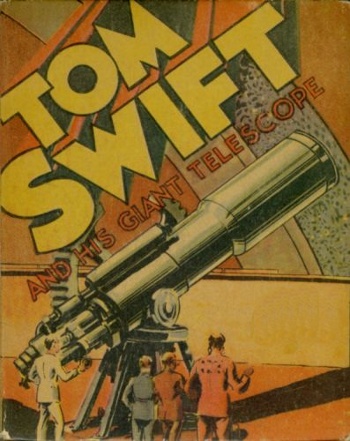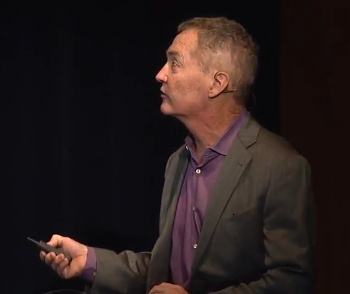Joseph Polchinski
October 30, 2017
Physicist,
Michio Kaku, and I are about the same age, so I was interested to see his recalling in a recent
interview a
pamphlet he had read in the
fourth grade.[1] The pamphlet asked the question, "What do physicists and
baseball players have in common?" The answer was that they both got paid for doing what they love. Sometime in my
childhood, I either read that same same pamphlet, or read the question somewhere else; and, of course, the answer is true.
That's why I was always surprised in my
professional career to meet
scientists for whom their work was just a
paycheck. I even knew one
tenured professor at a prestigious
university who bemoaned the fact that he didn't instead become a
physician, since he would be making more money. That was quite unlike my own experience, since, from an early age, I was fascinated by
science. I learned much science,
mathematics and
technology outside of my school
curriculum, and I couldn't imagine any other course in life than to be a scientist.
That's not to say that the path was easy. Those were the days before the easy access to
information provided by the
Internet, and
public libraries of that time had a very limited collection of science
books. Also, there was the typical assortment of unmotivated, and unmotivating, professors.
Ben Stein's economics lecture in the 1986
film,
Ferris Bueller's Day Off, would be an example of some of the lectures I sat through.[2]
Perhaps it's the influence of my own experience, but I think that most scientists are
born, not
made. As I wrote in an
earlier article (Teen Scientists, February 1, 2013), I had a home
laboratory while in
grammar school and
high school. When I started my career as a professional scientist, I found that many of my
colleagues had one as well. One thing that encouraged my home
experimentation was the annual
science fair we had from
sixth grade through high school.
I also enjoyed reading
science fiction books, such as the
Tom Swift, Jr. series. The Tom Swift books I read were a modernization of the original series, which featured
Tom's father. The many
space-themed films of that era were also an inspiration.
Wikipedia has a
listing of all titles in the second Tom Swift series. I remember reading the following:
• Tom Swift and His Flying Lab (1954)
• Tom Swift and His Rocket Ship (1954)
• Tom Swift and His Giant Robot (1954)
• Tom Swift and His Atomic Earth Blaster (1954)
• Tom Swift and His Outpost in Space (1955)
• Tom Swift in the Caves of Nuclear Fire (1956)
• Tom Swift on the Phantom Satellite (1956)

Cover of the 1939 book, Tom Swift and His Giant Telescope.
While I was interested in astronomy, I wasn't as interested as a high school classmate who hand-polished a twelve-inch mirror for a Newtonian reflector telescope as his high school science fair project.
He spent many hours hand-polishing the glass blank for the mirror and checking his progress using a razor blade in the traditional Foucault knife-edge test.
(Slightly modified Wikimedia Commons image)
Physicist,
John D. Kraus, whom I briefly mentioned in a
previous article (Optical Antennas, June 13, 2011) as the
inventor of the
axial mode helical antenna, was a pioneer in
radio astronomy. As he recalled in his
autobiographical book,
Big Ear, he too had a home laboratory as a child.[3] In 1920, at age ten, he built a
crystal radio and used the receiver from his family
telephone as an improvised
headphone.[3]
Having a home laboratory as a child isn't limited to just physicists.
Nobel Chemistry Laureate,
William Lipscomb, about whom I wrote in an
earlier article (William Lipscomb, April 18, 2011) had assembled a home
laboratory as a teen, making the usual assortment of
foul-smelling chemicals and
fireworks. Lipscomb, who had amassed a considerable quantity of
labware for his home laboratory, donated his equipment to his
high school at graduation.[4]
Such an early interest in science was also apparent for
theoretical physicist,
Joseph Polchinski, a professor of physics at the
University of California, Santa Barbara, and a permanent member of the
Kavli Institute for Theoretical Physics that's sited there. Presently recovering from
brain surgery, Polchinski has written an
autobiographical note, posted on
arXiv, that recalls his childhood interest in science.[5]

Joseph Polchinski, lecturing at the 2017 Breakthrough Prize Symposium, December 5, 2016.
(Still image from a YouTube Video.)
Polchinski is a noted
string theorist who is the
author of the 1998
textbook, String Theory. He is known for "
Polchinski's paradox" involving
time travel through a
wormhole, a common feature in science fiction. The paradox is notable for using an easily understandable
classical mechanical analogy involving a
billiard ball.
Polchinski was reading science books at age six, when he was in the
second grade, and he was interested in the usual topics at that age,
dinosaurs,
atomic energy,
chemistry, and
rocks and
minerals.[5-6] He writes that science in school never seemed as interesting as in such books, so he was more interested in mathematics.[6] As most young scientists, Polchinski read a lot of science fiction. At that time, books and
magazines were the principal domains of science fiction.[6] Science fiction author,
Isaac Asimov, also wrote educational books in science and mathematics, and Polchinski enjoyed reading those as well.[6]
Polchinski's scientific mindset was established early, as can be seen from some of his questions to his
teachers. He asked a physics teacher about the
speed of gravity, a question that wasn't answered.[5] He also had a problem with a
test question concerning the ranking of
fundamental forces, since he realized that
gravitation, the expected answer for the strongest force, was wrong.[5] He was also intrigued by the concept that
light was a combination of an
electric field and a
magnetic field that mutually created each other.[5]
Polchinski was gifted with a telescope as many young scientists were. This was a four-inch reflector at age twelve, and the viewing conditions near
Tuscon, where he lived, were excellent.[5] He was able to view many objects in the
Messier catalog, and he decided to build his own eight-inch reflector using the same techniques as my high school friend with help from the
University of Arizona astronomy club.[5] Even with this experience, Polchinski was more inclined to follow a
theoretical, rather than an
experimental, career. As he said in an interview, "Not surprising I'm a theorist, because I never had such an inclination to take
radios apart."[6]
In school, Polchinski was more interested in mathematics than science, taking some of the "
New Math" in
fifth grade. He describes "New Math" as actually rather bizarre, but it was perfect for him.[5] He recalls completing four years of mathematics courses in his junior/senior high school in just one, completing the curriculum through
trigonometry and
geometry.[5-6]

Base-12 addition in the "New Math." My mathematics education also involved the "New Math," in which we learned about number bases other than base-10. The "New Math" representation of ten and eleven was "t" and "e" as a way to make things easier on the students. (Image created with Inkscape.)
Having completed
advanced algebra, the highest level mathematics course offered in his small school, he spent his first high school year learning
calculus at the University of Arizona in evening classes. Having an uninspiring instructor, he didn't really see the point of calculus; but, later, taking physics in college, he discovered what calculus was really for.[5]
Weathering the assortment of lackluster teachers as many of us have, Polchinski was still able to excel as a scientist. One interesting
anecdote he tells is his
exploration of
Caltech's steam-tunnel network.[5] This is something that my friends and I did at another school, but we had a valid excuse. We were stringing
wires for the
low-powered campus radio station.
References:
- P.K. French, "Physicist Michio Kaku on STEM Education," Innotechtoday, October 11, 2016.
- "Anyone, anyone" teacher from Ferris Bueller's Day Off, Ben Stein as a teacher in the 1986 film, "Ferris Bueller's Day Off." YouTube video, December 29, 2011.
- John Kraus, "Big Ear," Cygnus-Quasar Books (Powell, Ohio, 1976).
- By Thomas H. Maugh II, "William N. Lipscomb dies at 91; won Nobel Prize in chemistry," Los Angeles Times, April 16, 2011.
- Joseph Polchinski, "Memories of a Theoretical Physicist," arXiv, August 31, 2017.
- American Institute of Physics Oral History - Joseph Polchinski, interviewed by Dean Rickles at the Kavli Institute for Theoretical Physics, March 18, 2009.
Linked Keywords: Physicist; Michio Kaku; interview; pamphlet; fourth grade; baseball player; childhood; professional; career; scientist; paycheck; tenure; professor; university; physician; science; mathematics; technology; curriculum; information; Internet; public library; book; Ben Stein; economics; lecture; film; Ferris Bueller's Day Off; laboratory; grammar school; high school; colleague; experiment; experimentation; science fair; sixth grade; science fiction; Tom Swift, Jr.; Tom Swift; outer space; space-themed; Wikipedia; astronomy; classmate; hand-polish; inch; mirror; Newtonian reflector telescope; glass; razor blade; Foucault knife-edge test; John D. Kraus; inventor; axial mode helical antenna; radio astronomy; autobiography; autobiographical; crystal radio; telephone; headphone; Nobel Chemistry Laureate; William Lipscomb; laboratory; hydrogen sulfide; foul-smelling chemical; fireworks; laboratory glassware; labware; theoretical physics; theoretical physicist; Joseph Polchinski; University of California, Santa Barbara; Kavli Institute for Theoretical Physics; neurosurgery; brain surgery; arXiv; 2017 Breakthrough Prize Symposium; YouTube Video; string theory; string theorist; author; textbook; Polchinski's paradox; time travel; wormhole; classical mechanics; analogy; billiard ball; second grade; dinosaur; atomic energy; chemistry; rock; mineral; magazine; Isaac Asimov; teacher; speed of gravity; test; fundamental interaction; fundamental force; gravitation; light; electric field; magnetic field; Tucson, Arizona; Charles Messier; Messier; astronomical catalog; University of Arizona; astronomy; club; theory; theoretical; radio; New Math; fifth grade; trigonometry; geometry; duodecimal; Base-12; addition; radix; number base; decimal; base-10; student; Inkscape; mathematics education; advanced algebra; calculus; anecdote; exploration; California Institute of Technology; Caltech; utility tunnel; steam-tunnel; wire; Title 47 CFR Part 15; low-powered campus radio station.